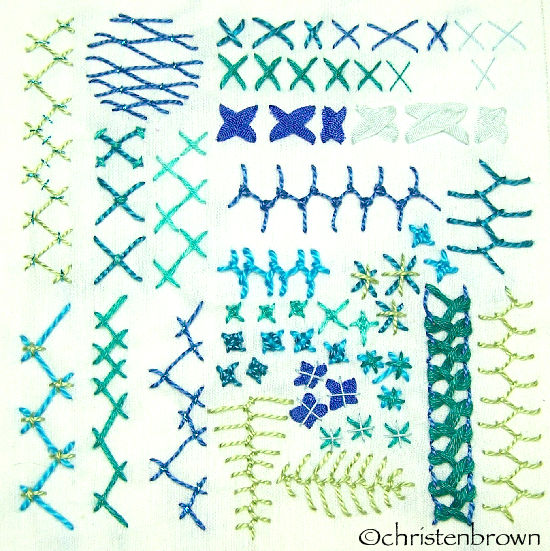


Well, that just makes sense!
- Practice, I do! If I could pass on one good suggestion, it would be to practice. Keep a piece of fabric and ball of thread on your work table, so that you can use it to familiarize yourself with a stitch, or to learn a new one.
- Always wash your hands before working with the fabric base, embroidery threads and ribbons.
- I keep a piece of cardboard with holes punched out to organize the unused portion of strands of floss. This way you will always be able to find the second half of the split skein.
- Take notes while you are embroidering, such as how many wraps the French knots were, or how many strands of floss you used for a stitch.
- Think of a mistake as a design opportunity that you had not thought of yet. Once you repeat a mistake, it becomes another element in the design.
Thread and Ribbon Specifics
Pearl Cotton and Cotton Floss
- All the embroidery threads that you work with will naturally twist. Periodically hold the fabric base upside down then let the needle dangle down, the thread or ribbon will unwind.
- To keep the threads from tangle free or from knotting, run the length of twisted thread or floss over Thread Heaven or Thread Magic. Repeat this if needed.
- The loose end of thread can sometimes wrap around the working thread and create a knot. If you periodically cut the loose end this should help.
- Keep the threads clean and dust free by storing them in a bag with a zip-lock closure. I have a separate bag for each project, and a smaller bag for the left-over odds and ends of for each project. You may never know when you need just a few inches to finish off a stitch.
Silk Embroidery Ribbon
- Silk embroidery ribbon has a tendency retain the fold from the packaging. Slightly moisten the length that you are working with, and then gently pass the ribbon over the upright plate of a warm iron.
- When embroidering with silk embroidery ribbons, in most cases the ribbon should lie flat against the fabric, however, the ribbon can twist once it is pulled through the fabric. If the ribbon is concave, hold the ribbon next to the fabric then stitch. If the ribbon is convex, rub the ribbon until it is flat, or concave.
Metallic Threads
- Use a pair of craft scissors to cut the metallic threads, trims, or lace, as the metallic finish can dull your good embroidery scissors.
Working with Colorways
Ombre, variegated and hand-dyed colorways can lend a unique touch to any embroidered design. When working with this thread I try not to think out the color way too seriously, I just cut the thread from the skein or ball and begin stitching. If it is imperative to have a similar colorway for balance, try these suggestions:
- For floss: split the skein of floss in half, and work one side, then the other.
- For perle cotton, cut the thread in equal lengths until you find a repeat.
You can also create your own unique color blend of by combining the same size or different sizes of perle cotton, or combining perle cotton with cotton floss. Cut a longer length than you would normally use for a single strand of thread.
- Combine 2 or more colors of the same or different weight of perle cotton threads into a large eye needle like a chenille needle.
- Cut 3 colors of floss, separate 1 or more strands from each length. Combine the lengths and thread these into the needle. For 3 strands, use and embroidery needle; if you are using more than one strand for each color, then change to a cotton darner or crewel needle.
Happy Stitching to you! ~Christen
PS: If you are looking for inspiration or ideas, check out my PDF Classes and books.
Practice, yes. Before that, learn from an excellent, creative embroidery teacher named Christen Brown.
Well, thank you my friend, but you should know that you came to me with experience and talent! That made my job easy!